I posted the design of the WI-1000XM2 back in August in this teardown post, and now with the model officially announced, it is time to find out what has changed and what has stayed the same.
For those interested in the press release, I have posted it at the end of this post. The post is split up into sections for easier reading, since he post is a bit long.
- Design differences
- Features: What is gone, what remains
- Underneath the skin
- Are they worth the upgrade?
Design differences
I will start with the design and compare both models. There are quite a few major changes in the design at first glance. The new design looks to be more compact with the band now much thinner and the side pods much shorter. The cable management system is now gone. Personally I am not sure how well this system worked, if you ask me, the groove was just another place for dirt and dust to collect.
With the side pods now much smaller, some controls and inputs have moved around. Gone is the micro-USB port, replaced with a USB type-C port. The position of the port has also changed, before it was located on the underside of the left pod but now it has moved to the side of the left pod. The new model also now features a 3.5mm jack beside the USB port, something which was absent on the old model. Because the pods are much smaller, Sony has moved the physical controls from the side to the left cord which now features a remote.
Another change are that cables themselves. They are now a flat design rather than the round design of the previous model. This should should minimize any cable tangles, since such flat cables return to their straight position more naturally. The NFC location has also changed, from the side of the right pod to the top of the right pod.
There will be 2 colours offered, black and silver with the colours identical to the WH-1000XM3 and WF-1000XM3. The weight has decreased from 71g to 58g, and the 61g to 44g for the unit itself. I do wonder how much of this drop is due to possibly a smaller battery, other components, less plastic or a combination of the 3.
The contents remain almost identical but updated, the headset, USB cable, headphone cable, carrying case, Hybrid silicone rubber earbuds (SS/S/M/L 2 each), Triple-comfort earbuds (S/M/L 2 each) and Plug adapter for in-flight use. I do like this new carrying case compared to the pouch in the previous model, it looks more premium.
 |
| Supplied Accessories |
 |
| Carrying Case |
Overall I feel the design looks much better and more premium than what the leaked photos indicated but that was a pre-production prototype so understandable. I do they sound as good as they look. If anyone was able to test these out at IFA, post your thoughts below.
Features: What is gone, what remains
The features and specifications are very similar between the 2 models. Both have the same frequency response 3 Hz-40,000 Hz, both have a Hybrid Driver System featuring a 9mm driver and a Balanced Armature driver and both have identical sensitivities. While not mentioned on the product page, the WI-1000X also has dual mics for noise cancellation, same as the new WI-1000XM2. One feature missing from the new model is the S-Master HX, more on that later.
The identical battery life to the previous model is a concern, we are looking at 10 hrs (NC ON), 10 hrs (Ambient Sound Mode), and 13 hrs (NC OFF). Realistically I feel 8-9 hours in real world conditions. Perhaps Sony's desire to minimize weight came at the cost of battery capacity. The weight has decreased from the previous model, how much of this is due to the battery size is unknown. I am sure any decrease in capacity is offset by using the new MT2811 Bluetooth 5.0 chip but I guess this was not enough to increase the battery life.
 One major feature that sets the WI-1000XM2 apart is the addition of the QN1 NC chip from the WH-1000XM3. The photo on the left is actually from the WH-1000XM3, but I will post the photo for the WI-1000XM2 later on in the post. Back to the battery, I do not believe the QN1 is the cause of this identical battery life since even with NC off, the battery life is the same as the previous model. Since the battery capacity of the old model is unknown, it will be hard to compare it to the new model. It would be unfortunate if Sony decided to decrease the battery capacity to save on weight.
One major feature that sets the WI-1000XM2 apart is the addition of the QN1 NC chip from the WH-1000XM3. The photo on the left is actually from the WH-1000XM3, but I will post the photo for the WI-1000XM2 later on in the post. Back to the battery, I do not believe the QN1 is the cause of this identical battery life since even with NC off, the battery life is the same as the previous model. Since the battery capacity of the old model is unknown, it will be hard to compare it to the new model. It would be unfortunate if Sony decided to decrease the battery capacity to save on weight.
Both models have DSEE HX and Atmospheric Pressure Optimization which optimizes the NC for high altitude. I do not see any mention of the Sense Engine in the new model and Vibration for call has been removed (see below).
Another major difference is the absence of aptX and aptX HD support. Only LDAC support remains and this is probably due to Sony dropping Qualcomm as their BT chip supplier, moving to Mediatek. I am not sure if aptX requires specific hardware or can be driven by software like LDAC. If it only requires software, then I suspect Sony did not want to pay royalties to Qualcomm for aptX.
Here is a link to various functions the WI-1000XM2 supports via the Sony | Headphones app. But to summarize some of the differences and similarities:
Features WI-1000X and WI-1000XM2 share:
-Adaptive Sound Control
-Ambient Sound Control (seamless control)
-Ambient Sound Control (mode switching)
-Noise Canceling Optimizer(Atmospheric Pressure Optimizing)
-Equalizer
Features only present on WI-1000X
-vibration for call alert
-Sound Position Control
-Surround (VPT)
The WI-1000XM2 does have automatic download of software via the app and notification and voice guide.
Underneath the Skin
A full teardown does not exist but the leaked certification documents do provide some insights into the guts of the WI-1000XM2. First the QN1 chip, Sony has kindly provided us with the photo below which shows the QN1's position on the PCB.
I tried matching this up with the photos from the certification and came up with the following below. The BT chip can be seen on the left, the MT2811SP/A, same as in the WF-1000XM3, and on the right is what appears to be the QN1.
 |
| Click for larger size |
I cannot make out the writing on the chip, but it is either CXD98050, or CXD96050. Checking Google for such a part does not reveal anything specific, but Sony does not publish all their part numbers. When comparing to the QN1 from the WH-1000XM3, see here, the chip also appears to be labelled with the text SONY, so it might be the same chip, but not confirmed 100%.
For those interested, I got the WH-1000XM3 photo from the FCC here but it is really low quality, so the number is illegible at this time. If anyone has any clear photos of the QN1 chip from the WH-1000XM3, please do link them below. But please do not disassemble your own WH-1000XM3, since you may not be able to put them back together and might damage something in the process.
For those interested, I got the WH-1000XM3 photo from the FCC here but it is really low quality, so the number is illegible at this time. If anyone has any clear photos of the QN1 chip from the WH-1000XM3, please do link them below. But please do not disassemble your own WH-1000XM3, since you may not be able to put them back together and might damage something in the process.
Flipping over to the other side of the WI-1000XM2 PCB shows the following.
 |
| Click for larger size |
Not much in the sense of anything specific but one of the chips seems to be identical to a WF-1000XM3 chip, Q128FWF, which is a memory chip. The blueish chip beside this is a mystery, the text on it is too small to read, so not sure what that is. I originally thought it was a S-Master HX chop but it does not match the actual chip which is a square and this one is more of a rectangle.
 The S-Master HX chip is the D3778 according to Sony, I found the photo and description right here. The chip has a similar naming scheme as the other similar chips from Sony as seen here. In the WF-1000XM3 teardown, the QN1e was identified as the CXD3781GF, since it was labelled as D3781.
The S-Master HX chip is the D3778 according to Sony, I found the photo and description right here. The chip has a similar naming scheme as the other similar chips from Sony as seen here. In the WF-1000XM3 teardown, the QN1e was identified as the CXD3781GF, since it was labelled as D3781.The actual S-Master HX is the CXD-3778GF, and quite a few Walkmans use it, like the ZX300, A40/50, WM1 line, and new A100.
I will have another post about the S-Master in the future, so stay tuned for that. Back to the WI-1000XM2, no S-Master HX is mentioned on the product page, so I doubt it actually has the S-Master HX. Below are photos of the older WI-1000X, I was curious if I could find the S-Master HX in some teardown photos.
 |
| Click on photo for larger size |
There does not appear to be anything that looks like the S-Master HX on this side of the PCB so it is probably on the other side. I could not find any high resolution photo but managed to find the following photos below, they are the best we have for now.
 |
| Source: https://www.mydigit.cn/forum.php?mod=viewthread&tid=25248 |
I have outlined a chip that is the best candidate for the S-Master HX. It is square and has a blueish shiny appearance like the CXD-3778GF in other devices. So while this does not confirm the presence of the S-Master HX, it does provide some indication a S-Master HX-like chip is present on the old model but absent on the new WI-1000XM2.
So the question is, why would Sony remove the S-Master HX from the new model? Likewise, the MDR-1000X and WH-1000XM2, both had the S-Master HX but the new model WH-1000XM3 lacks any S-Master HX on the product page. The answer is simple, the new QN1 apart from providing improved NC performance, also acts as a DAC and Amp (see below).
 |
| Source: https://lyra.media/news/Local-News-Sony-WH-1000XM3-NW-A50/ |
So instead of having 2 chips, one for NC and one for an DAC/amp, Sony has combined them into one. Sony seems to be keeping quiet about the QN1, unlike their S-Master HX which they have identified, the QN1 chip number has not been revealed. Perhaps the chip is the CXD98050, or CXD96050, but it is puzzling that the smaller QN1e from the WF-1000XM3, identified as the D3781, has a different labeling and lacks any Sony branding.
In a feature page on Sony Japan, Sony explains the QN1e as the same chip as the QN1 but in a smaller package and more power efficient.
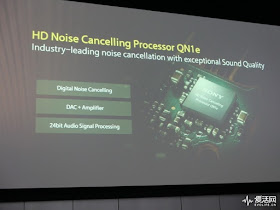 |
| Source: https://www.gizmochina.com/ |
This is from a presentation Sony gave when the WF-1000XM3 was released, and just like the bigger QN1, the smaller QN1e also has NC, DAC+ amp and 24-bit audio signal processing. Less than the 32-bit processing of the larger QN1, so perhaps this is where the power savings come in. Again all speculation for now, but intersting nonetheless.
It makes me wonder why Sony decided to use the larger QN1 versus the more power efficient and smaller QN1e in the WI-1000XM2. I know there is more space in the WI-1000XM2 compared to the WF-1000XM3, but maybe battery life could have been improved if the QN1e was used instead of the QN1. Regardless, using the QN1 does set the new model apart from the previous one and is a big plus.
Are they worth the upgrade?
The new WI-1000XM2 seem like a decent upgrade over the previous model and I quite intrigued to try them out. I really like the new design, the smaller size and lighter weight. The addition of the QN1 chip is a big plus and the 3.5mm jack is a better choice since you do not have to open the USB flap each time you wish to listen to it wired. The new travel case looks great and Sony mainting the same price point is welcomed.
But the lack of any improvement in batter life is quite disappointing, as is the January 2020 availability. I was really looking forwards to getting these for the holidays but it appears Sony has other plans. On the bright side I have more time to save for the new model. But if Sony wishes to send me a review unit, that would be great.
So is the new model better than the old one? In my view, yes, but only just sligthly, the 3.5mm jack and QN1 are the major selling points for me, but if I found the older model for a heavy discount, I would definitely consider buying it if I needed a new wireless headset.
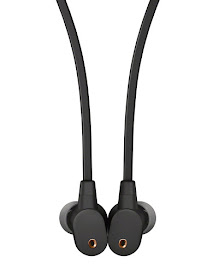 |
| Magnetic buds to minimize tangles |
Press release
- Enjoy the next level of silence with the WI-1000XM2, thanks to the newly-developed HD Noise Cancelling Processor QN1
- With the next generation neckband in the 1000X family, experience superior sound quality and all-day comfort
- Smarter listening to customise your audio experience
The next level of silence
Immerse yourself in music and banish background noise with the WI-1000XM2 which cleverly prevents, catches and cancels ambient sound. The stable fitting structure with an angled earphone design helps prevent ambient noise from entering the ear while the Dual Noise Sensor technology catches any noise. Sony’s HD Noise Cancelling Processor QN1 then cancels the sound, resulting in an improved noise suppression level. Even aircraft cabin ambient noise is effectively cancelled thanks to the Atmospheric Pressure Optimising function. Enjoy in-flight music with perfect clarity as the Noise Cancelling adapts to high altitudes.
Premium Sound
Experience your favourite music like never before with exceptional, premium sound on the WI-1000XM2. Despite their compact size, the neckband buds include a HD Hybrid Driver System which contains a 9mm dynamic driver and Balanced Armature driver. This creates stunning and wide range frequencies by reproducing clear sound from deep bass to delicate high tones. The built-in HD Noise Cancelling Processor QN1 features 32-bit Audio Signal Processing, high quality Digital to Analogue conversion and a headphone amplifier. This ensures a high signal-to-noise ratio, with a low level of distortion, for music play back with superior quality. Digital Sound Enhancement Engine HX (DSEE HX) upscales compressed digital music files including MP3 formats, to bring you closer to the quality of High-Resolution Audio.
Listen in comfort
The WI-1000XM2 offers improved comfort with a silicone neckband for flexible fitting and a lighter weight. The earbuds fit deeply in the ear thanks to the angled earphone design, so you can listen all day in comfort.
Revolutionise your listening experience
The WI-1000XM2 also has a great battery life of up to 10 hours, so you can power through your day. With Quick Charging capability, 10 minutes of charging equips you with 80 minutes play time.
The WI-1000XM2 has an intuitive operation thanks to its control unit and enables clearer hands-free calling due to a built-in dedicated microphone on the same control unit. When you’re done listening, the magnetic earbuds snap together neatly for a tidy stowaway to help you avoid tangles. Fold away your earphones in the premium fabric carrying case with compact precision, which can also store an audio cable, USB cable and plug adapter for in-flight entertainment.
This model features Adaptive Sound Control which allows you to listen your way by automatically changing the headphone sound settings depending on your activities. The WI-1000XM2 becomes convenient with voice assistant. Manage your day, just by asking your favourite voice assistant. Enjoy entertainment, connect with friends, get information, set reminders and more. These headphones are also compatible with the dedicated Sony | Headphones Connect app so you can personalise your music as easily as your style.
The WI-1000XM2 model will be priced at approximately €330 / £300 and available from January 2020.
End of Press release


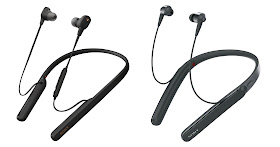

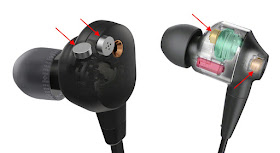

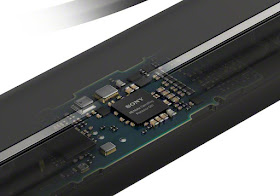
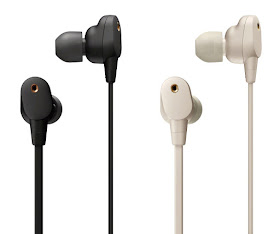
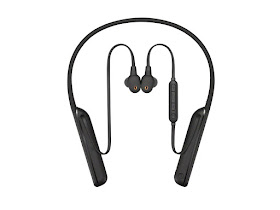
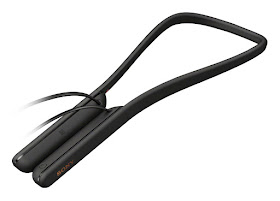








I tried them out on the IFA this year and was very stunned by the noise canceling. It truly blocked out the noisy IFA crowds.
ReplyDeleteI have never tried the previous model, so, unfortunately, I can not compare.
The sound quality seemed very good, but I was only able to try them out for a few minutes. They definitely have depth and sufficient heights. I only played one bassy peace, but they did better than expected - overears I've had still got more bass.
Thank you for this comparison. I believe I will most likely buy the new one's, but this post was very interesting.
Now for safety, proof of IFA visit:
http://imgbox.com/pTrUTFDW
http://imgbox.com/qk176SaI
Only photos I took of them, unfortunately. I dislike crowds.
Hopefully these will be offered in north america, otherwise I will have to import them from japan or europe. Only thing I wish that was different was the driver size, slightly bigger (12mm) and a larger battery, more than 290mAh.
DeleteHi, I have purchased a headphone like this, which contains an old 0.9.7 firmware variant. Do you have any idea how to update it? The automatic update process does not show any new firmware variant, but the actual one is 1.1.2 as far as I know. Do you have any idea how to update it? Sony asked to bring to local service shop, but I don't find the the invoice..(which means there is no warranty)
ReplyDeletehmm I do not see any firmware updates on any of the support sites
Deletehttps://www.sony-asia.com/electronics/support/wireless-headphones-bluetooth-headphones/wi-1000xm2
https://www.sony.co.uk/electronics/support/wireless-headphones-bluetooth-headphones/wi-1000xm2
https://www.sony.com/electronics/support/wireless-headphones-bluetooth-headphones/wi-1000xm2
Can you link me were you see the new firmware? Also any updates should be done via the app, Sony | Headphones Connect.
Wi-1000xm2 are much better than wi-1000x on some points and lose on others and considering the price different.
ReplyDeleteBiggest plus is they fold nicely and have usb-c + separate audio jack...and BT 5.0 with maybe less interference.they may be more comfortable...
For anything else the V1 is better and NC seems more or less the same
I disassembled my WI-1000X and have high resolution PCB pictures. If you need a photo, I provide it for free. Contact me.(I just disassembled it for repairs, but I will also disassemble WI-1000XM2 later...)
ReplyDeleteDo you find the sound quality of the XM2 better than the 1000x?
DeleteIn the text, the chipset in the red box called "S-Master HX" is marked "3775A 726 A88Z"
ReplyDeleteThe other chipset is maked "CSR 8675 CG K722GNM"
Finally, when flipped, there are two chipsets: "TM 90020 FW1727"
Hope it helped.
Hi there, that is awesome, if you can please email them ascariss@gmail.com. I will post them up with credit.
Delete